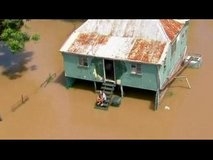ROCKHAMPTON, Australia (Reuters) – Australia\'s record floods are causing catastrophic damage to infrastructure in the state of Queensland and have forced 75 percent of its coal mines, which fuel Asia\'s steel mills, to grind to a halt, Queensland\'s premier said on Wednesday.
 |
| Reuters – Australia braces for more floods |
 |
| Reuters – A stop sign is seen near a house partially submerged in floodwaters in Rockhampton, Queensland, January… |
The worst flooding in decades has affected an area the size of Germany and France, left towns virtual islands in a muddy inland sea, cut major rail and road links to coal ports, slashed exports and forced up world coal prices.
"Seventy-five per cent of our mines are currently not operating because of this flood, so that\'s a massive impact on the international markets and the international manufacture of steel," Premier Anna Bligh told local television.
Queensland state is the world\'s biggest exporter of coal used in steel-making.
"Queensland is a very big state. It relies on the lifelines of its transport system, and those transport systems in some cases are facing catastrophic damage," said Bligh.
"Without doubt this disaster is without precedent in its size and its scale here in Queensland. What I\'m seeing in every community I visit is heartbreak, devastation."
Residents in flooded towns worked desperately to build sandbag levees on Wednesday in the hope of holding back the rising waters. In the cattle town of Rockhampton, a rise of just 20 cm (8 in) in floodwaters would inundate another 400 homes and lap at the front door of a further 4,000 properties.
"It\'s rising very slowly. We\'re hoping against hope that we might not reach the 9.4 meter (31 ft) mark. Let\'s hope we dodge the bullet. Every centimeter counts," said Queensland state disaster co-ordinator Ian Stewart.
Some 200,000 people have been affected by the floods and three have drowned. Authorities are warning people to stay out of floodwaters, not just because of the risk of drowning. Snakes and crocodiles are being washed into homes and shops.
Macarthur Coal said on Wednesday it had resumed transporting coal by rail to Dalrymple Bay Coal Terminal this week, but force majeure remained in place and future coal trains will depend on coal availability.
"Once the pits are free of water, we\'ll have more coal exposed that can be processed and transported," said Nicole Hollows, Macarthur\'s managing director.
"But it is not possible to predict when we will return to a steady state of mining as that largely depends on any future rain."
Wesfarmers is also resuming output at its Curragh mine in the Bowen Basin, but retained its declaration of force majeure, which releases companies from contractual obligations.
A spokesman for Dalrymple port warned that unless mine companies resume production in the nation\'s biggest coal region soon, coal export shipments could again be cut.
Coal mines with an annual capacity of more than 90 million tones are under force majeure.
Australia accounts for more than half of global coking coal exports, which are vital to steelmakers, especially in Asian countries such as booming China.
The floods have hit 35 percent of Australia\'s estimated 259 million tones of coal exports in 2009. An estimated $1 billion has been lost in coal production due to the floods, said the Queensland Resource Council.
FRESH FLOODS FEARED
While floodwaters are receding in the Bowen Basin coal region, flooding continued further downstream and fresh monsoonal rains are forecast to cause fresh flooding.
Flood warnings have been declared for seven river systems, with one swollen river now 6 km (4 miles) wide.
"It\'s going to be two weeks before people...are able to move back into their homes," said Rockhampton mayor Brad Carter.
Residents in the town of St George have built dirt moats to try and stop the floodwaters reaching their homes, but authorities fear 80 percent of the small town will be swamped if the Balonne River reaches a record 14 meters on Saturday.
"It\'s started to rain here again. We could get a flood on top of our (earlier) flood," said Barnaby Joyce, a National party senator who lives in St George.
The Australian floods, which have cut off 22 towns, have been caused by a "La Nina" weather pattern which produces monsoonal rains over the western Pacific and Southeast Asia.
Australia recorded its third wettest year on record in 2010, with 11 months of above-average rainfall soaking the east of the country because of La Nina, the nation\'s weather Balonne River reaches a record 14 meters on Saturday.
The flood disaster, say analysts, is forecast to shave around 0.4 percentage points off GDP, which equates to just over A$5 billion of Australia\'s annual output of A$1.3 trillion.
"The cost is already in the billions and billions of dollars. And that\'s in public infrastructure, private dwellings and possessions, crop losses, stock losses, business impacted," said Queensland Emergency Services Minister Neil Roberts.
"It\'s just going to be an enormous bill, and it\'s going to take a long, long time to recover."
